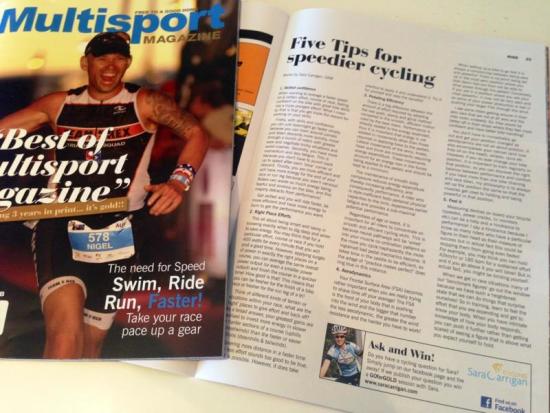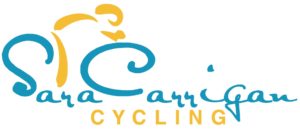Posted by Sara Carrigan – Columnist for Multisport Magazine
1. Skilled confidence
When wanting to average a faster speed for a certain effort, course or race, feeling confident on the bike with great bike skills has a triple pronged effect! What I mean by that is that you get triple the reward for working on your skills.
Firstly, with skills and confidence you can you can just downright go faster simply because you can hoon around corners and down descents more quickly, move through a bunch of riders with greater ease and negotiate tricky situations and avoid crashes. Secondly, you have more momentum and less fatigue. This is because you don’t have to punch back up to speed after each ‘slow’ corner or descent. Thirdly, you are more efficient and will have more energy for the end of your race or run leg because you aren’t nervous! Riders can waste so much energy being fearful and anxious on the bike, and this majorly detracts from performance!
Get skilled and you will ride faster, be more efficient and have more energy to burn to get the performance you want.
2. Right Place Efforts
This all about being smart and savvy in knowing exactly when to dig deep and when to save energy. You may think that for a particular effort, course or race if you hold 400 watts for every minute that you will post a good time. However, applying surges of power in exactly the right places on a course, you can average the same overall power output (or even a smaller power output) and finish the course in a quicker time! How good is that! This means that you can be fresher for the finish of a bike race or fresher for the run leg of a tri!
Think of different kinds of terrain or situations within your race, what are the ‘right’ places to give effort and back off? As a broad answer, your greatest gains are realised to invest more energy in slower or harder sections of a course (uphills & headwinds) than the faster or easier sections (downhills & tailwinds).
Covering more distance in a faster time with less effort sounds too good to be true, but it is possible. However, it does take practice to apply it and understand it. Try it for yourself and reap the benefits!
3. Pedalling Efficiency
There is a big difference between the amount of effort required by adopting the raw push, stomp and grind method compared to the smooth, efficient motion used by the best riders. Performance is directly related to the energy expended, thus it is important that energy is not wasted in movements other than those required in applying force to the pedals. Lateral movements of the arms, knees, head and trunk are movements requiring energy expenditure. These movements account for an energy loss in the forces being applied to the pedals and should be kept to a minimum.
The maintenance of smooth body composure reduces energy expenditure thereby increasing efficiency, and consequently performance. A rider who is style‐inefficient tests personal physical capacities to the limit, experiences earlier fatigue and provides a sub‐maximal potential performance.
Regardless of age or event, it is important for all riders to concentrate on smooth and efficient cycling skills. This is because neural pathways will be ‘wired’ into your muscle co‐ordination patterns so the more you cycle haphazardly the more ingrained bad pedal mechanics become. It takes time in the saddle to be efficient, so the adage of “practice makes perfect” does ring true in this instance.
4. Aerodynamics
Your Frontal Surface Area (FSA) becomes rather important when you are really trying to shave time off your average! The FSA is the front of your body that is pushing into the wind and the bigger that number the less aerodynamic, the greater the wind resistance and the harder you have to work!
When setting up a bike to go fast it is always a compromise between being aero and powerful! There is no point being set up in the most aero position where you look damn fast but then not be able to drive power through the pedals! Conversely, if you are in a position where you are your most powerful, it may not be very aero and so some of your power production is lost in pushing your larger FSA through the wind.
I see some riders getting around in their aero bars that are not at all aero and the rider looks unsteady. So, they would be better off in their drops where they feel more confident and have better bike handling!
You don’t have to immediately go out and get your position changed as aeordynamics are not all about position, it also encompasses your helmet (and how they sit on the head), wheels, lycra etc . However, if you do ever change your bike position, it is important to train regularly in that position, so you can discover the right balance between performance and comfort. If you have more than one bike (training and race bike), my philosophy is to always set up the position the same so that the muscles get used to holding and being powerful in that position.
5. Feel it
Measuring devices on board your bicycle (speedos, power cranks, hr monitors etc) can be a help and a hindrance to performance! I say a hindrance because I know so many riders who have a particular figure in their head as their measure of success but in actual fact this could be stopping them from going even faster! For example, you may think you can hold 42km/hr or 180 bpm for a sustained effort and if you go above it you will blow! But in actual fact, you might be limiting yourself.
When we get in race situations many of our ‘benchmark figures’ go out the window because we have such a heightened state that we can do things that surprise ourselves! So in training, learn to feel the effort that you are expending and get to know your body. When you have intimate knowledge of how your body responds, you can push it further rather than getting scared of seeing a figure that is above what you expect yourself to hold.
Check out article here: www.multisportmagazine.com.au – Multisport Magazine is educational, inspiring and entertaining. It connects with the local athlete – whether a professional or purely for social enjoyment, they are committed to improving their lives through healthier living and taking advantage of great opportunities.


